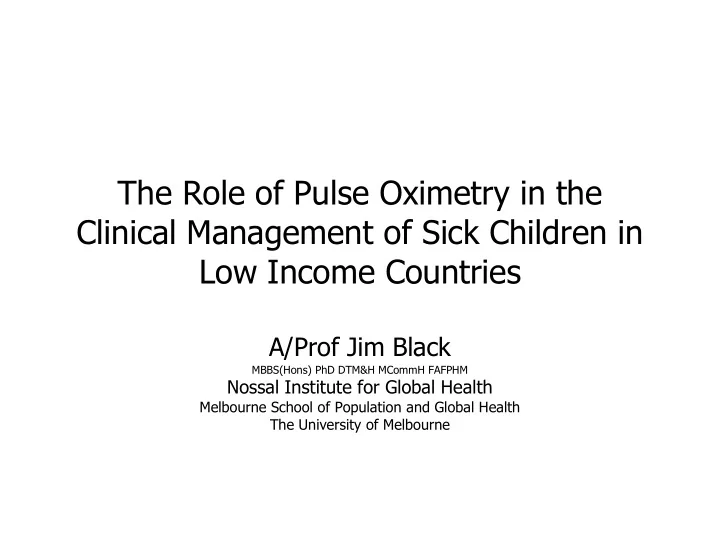

The Role of Pulse Oximetry in the Clinical Management of Sick Children in Low Income Countries A/Prof Jim Black MBBS(Hons) PhD DTM&H MCommH FAFPHM Nossal Institute for Global Health Melbourne School of Population and Global Health The University of Melbourne
A personal view... 1897-91: General duties doctor Morrumbene District, then Chicuque Rural Hospital, in Inhambane Province, Mozambique. Health Centre No 1 and Provincial Hospital ED in Pemba City, Mocímboa da Praia district in Cabo Delgado Province. 1994-98: Epidemiologist Provincial Health Directorate, Manica Province, Mozambique. 2007-14: Researcher Convenor of a multi-disciplinary group seeking technical solutions to some of the common problems seen in small district hospitals and sub-district health centres. (Thus possibly a pessimistic view of the problems but a very optimistic view of the possibilities…)
What oximeters measure Oxygenated haemoglobin absorbs light most in the infrared, while de-oxygenated haemoglobin absorbs in the red. A little extra blood enters the tissues with each heartbeat, slightly increasing the absorption. The relative increase in absorption in the red and infrared allows a calculation of the percentage of the haemoglobin that is oxygenated – the 'oxygen saturation' (SpO 2 ). For normal SpO 2 heart function, ventilation and gas exchange must all be normal. Low SpO 2 means one or more is not working but does not say which. Low SpO 2 is a specific test for severe illness but not very sensitive for illness itself (e.g. many children with pneumonia have normal SpO 2 ).
The working environment Enthusiastic and hard working health workers with relatively little training and intermittent supervision (at best). Very low budgets and over-stretched supply chains, and unhappy past experiences with new technologies. Commonly no or unreliable electricity supplies, and possibly only hand-drawn water. Difficulty with referral of ill patients – long distances, poor public transport, competition for fuel and cars. A culture of ‘queue clearing’. Health workers have little access to diagnostic services and learn ‘safe’ shortcuts – they tend to ask fewer questions and give broader-spectrum treatments as the day wears on.
The working environment Probably not so bad for Community Health Workers, who Have better supervision and supply chains (at least while outside support remains) See fewer patients per day, and less pressure for 'queue clearing' Are more likely to continue using the algorithms they are trained to use But they Still may not have reliable electricity or water Still may have great difficulty referring patients to the health service
Options Option 1: Use oximetry for its sensitivity in detecting severe – illness. Screen all children, (or at least all 'sick' ones) and – include oximetry as one of the first steps in assessment. This may be more appropriate in the Community Health – Worker setting? Option 2: Use oximetry for its specificity – A child with low SpO 2 is – nearly always quite sick. Use it to test the severity of illness after a positive – screening test (such as fast breathing). Include oximetry as one of the last steps in the algorithm. Perhaps more appropriate in the health facility setting? –
Deciding between options The best option may also depend on the technology 'form factor': Current single-purpose fingertip and hand-held oximeters do not provide decision support and require some operator skill. Possibly best suited to 'option 2' (oximetry after a screening test to check for severity). If a new type of device can be developed that requires less operator skill and has integrated decision support it may be more appropriate for 'option 1' (oximetry early in the assessment to screen for severe illness). Expert opinion and experience from industrialised countries will be helpful, but so would rigorous trials of different options and devices in the various developing country settings.
Recommend
More recommend